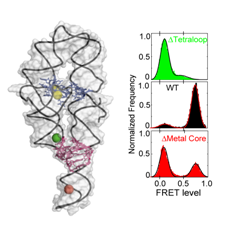Ongoing Research Topics
The overarching goal of the Herschlag Lab is to understand the fundamental behavior of RNA and proteins and the resulting biological ramifications.
Toward this end, we are primarily focused on the topics listed below:
Ketosteroid Isomerase Catalysis
Enzyme Promiscuity, Evolution, and Phosphoryl Transfer
RNA Catalysis
RNA Folding
 The repertoire of biological functions of RNA goes well beyond that of an information-carrying intermediary between DNA and proteins. RNA plays roles in a broad variety of cellular processes. In many cases, functional proficiency of RNA molecules is tightly linked to their ability to fold into specific, active conformations. Indeed, the molecular constituents of RNA render it highly prone to folding into highly stable structures. This tendency may have aided RNA as the central informational and functional molecule early in evolution in an ‘RNA World’. In modern-day biology, this tendency of RNA to form stable structures likely led to the evolution and preponderance of RNA chaperones –i.e., proteins that help RNA unfold, explore its conformational space, and undergo functional conformational changes.
The repertoire of biological functions of RNA goes well beyond that of an information-carrying intermediary between DNA and proteins. RNA plays roles in a broad variety of cellular processes. In many cases, functional proficiency of RNA molecules is tightly linked to their ability to fold into specific, active conformations. Indeed, the molecular constituents of RNA render it highly prone to folding into highly stable structures. This tendency may have aided RNA as the central informational and functional molecule early in evolution in an ‘RNA World’. In modern-day biology, this tendency of RNA to form stable structures likely led to the evolution and preponderance of RNA chaperones –i.e., proteins that help RNA unfold, explore its conformational space, and undergo functional conformational changes.
In the Herschlag lab, we study RNA folding at all level, from complex functional RNAs that reveal the behavior of molecules with functional biological roles, to simple model systems that allow us to interrogate the energetics that underlie the folding and behavior of RNA molecules. The former approach has required the use of cutting edge technologies, including single molecule fluorescence, small angle X-ray scattering, EPR, and the development of new dynamics and and other methods. The latter approach has provided some of the first critical tests of theory and provides guides for the develop of new computational approaches.
Most generally, we can view RNA folding as modular, and this modularity greatly simplifies the process, facilitates energetic and conceptual dissection, and allows us to break down complex behaviors into simple physical concepts. RNA secondary structure, double-stranded helices, are generally stable; the forces between them are largely electrostatic and greatly modulated by the ‘ion atmosphere’ that surrounds all polyelectrolytes. These helices are linked by junctions, and we are exploring the conformational behavior of these junctions and how they bias the conformational space of the attached helices and thus affect the folding stability and specificity; this work has analogy to the development of the Ramachandran plot for peptide conformational preferences. Finally, RNA is linked together in tertiary space by motifs, RNA structural units that can be used multiple times within a folded RNA and are used common to many different folded RNAs. Our goal is to reach a physics-based level of description of RNA folding landscapes. We believe that such level of understanding of macromolecular behavior is a necessary step towards understanding the workings of complex biological machines, and, eventually, the process of life.
Like other projects, our work in RNA folding is highly interdisciplinary, involving biochemistry, molecular biology, chemistry, and physics. Some leading papers from the lab in the area of RNA folding are: